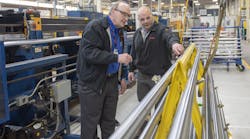2018 IW Best Plants Winner: Raymond Corp. Strives for Excellence in OEE and Beyond
Innovation, quality and service are the tenets of Raymond Corp., a subsidiary of Toyota that manufactures forklift/lift truck/pallet jack/and reach trucks. The 98-year-old company has logged a number of firsts over the years, including the hand pallet (1939), the electric narrow-aisle forklift (1949), and automated lift trucks (2012).
But that doesn’t mean resting on its laurels. Tuition reimbursement of 100% for qualifying coursework, and skills contests in areas like quality inspection and welding (with the winners traveling to Japan to compete with other top Toyota performers), have helped create a dynamic work environment at Raymond’s main manufacturing facility in Greene, New York.
“We’re trying to foster a learning approach, because the business is changing,” says CEO Michael Field.
Volume at the low-volume, high-mix plant is at record highs with the boom in e-commerce boosting demand for the company’s products.
Meanwhile, Raymond is maxed out in its operations square footage, both at Greene facility and at its sister plant in Muscatine, Iowa, with no room to expand. So one facet of the company’s robust continuous improvement program involves constantly looking for new ways to configure operations and move and store materials in the most efficient way possible.
The Greene plant began its continuous improvement journey in 2006 with the implementation of the Toyota Production System. Getting buy-in from employees took lots of planning and hard work, and it paid off: employees talk knowledgeably with outsiders about their jobs and how they fit in with the larger operation. Plant visuals are that golden combination of quick-to-read and informative.
When TPS was implemented, the Greene plant had a 2.85% defect rate annually. Now the target is .01%, “and we’ve done steadily below that in the past few years,” says Tony Topencik, director of manufacturing operations. A reduction in warranty claims paid was helped along by a 2011 initiative requesting dealerships ship back all of the defective parts from warranty claims, and then assigning an engineering team to do root-cause analysis on the parts.
Raymond Corporation
Greene, New York
Employees: 1,700
Total Square Footage: 902,000
Primary Products: Forklift/lift truck/pallet jack/and reach trucks
Start-up Date: 1922
Achievements
- Production has steadily increased from 5,590 trucks in 2008 to 20,210 in 2018.
- Productivity increased 9.6% in the past three years.
- Cost per unit shipped decreased by 8.5% in past three years.
- Unplanned downtime per piece of equipment reduced from 15.59 hours per year in 2016 to 1.55 hours per year in 2018.
- Warranty claims paid steadily decreased from a high of over $80,000 per month in Oct. 2011 to under $5,000 in Dec. 2018.
Revenue per production head has risen from $62,000 in 2010, to $120,000 in Oct. 2018. The workforce has grown too, up from 750 in 2009. Fortunately, the Greene plant is in a good place for retraining shop-floor workers, being the largest employer within a 50-mile radius.
Field says that the plant may not be as far along on its digital journey as some others because it was important to understand TPS from the ground up before implementing digital. They are in the early stages of IIoT adoption: figuring out how best to augment their kaizens and leadership circle meetings, which rely heavily on paper charts, photographs and handouts, with data analytics.
With 70% of costs for materials handling companies being labor, Raymond is prioritizing innovation in warehouse telematics and automated M&H solutions.
“We’ve done quite a bit of forward planning,” says Field. We’ve had five-year plans making sure we’ve built the right equipment set and the right capabilities to grow our core competencies in the areas that really matter.”
Improving Operational Equipment Effectiveness has been an ongoing challenge, but thanks to a Total Process Reliability program in place for the past several years, the plant has made strides. Whereas the old attitude at the plant was “I operate it and you fix it,” the attitude now is “We are all responsible for our own equipment.”
They’re at 61.59% Operational Equipment Effectiveness, and the goal is to hit 75%.
“We’re doing a lot of things to continue to grow the company, reate this learning organization, create a familial workplace,” says Field. “Things are moving in the right direction. The team is continuing to progress every year.”





